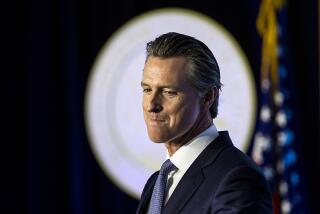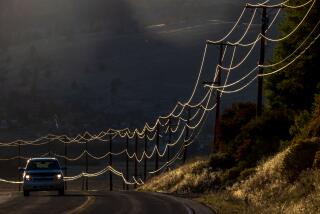State Unveils Renewable Energy Plan
In a major push to encourage use of renewable energy sources, the California Energy Commission Wednesday released a plan to meet almost half the state’s new electric-power needs with wind, biomass, solar and geothermal generation.
If the plan is approved by the Public Utilities Commission, California would become the first state to require that a specific portion of its power needs be met by such sources. Under the proposal, renewable-energy companies would no longer have to compete head-to-head with fossil-fuel generating plants but would have a share of the business reserved exclusively for them. The plan would set aside for renewable energy companies contracts to provide as much as 1,700 megawatts of the projected 3,500 new megawatts of electric power the state will need over the next 10 years.
“This is the biggest boost that the industry has ever had,” said V. John White, executive director of the Coalition for Energy Efficiency and Renewable Technology, or CEERT, a group of independent power producers, environmentalists and energy efficiency services formed last April.
“We have become the first state in the nation to formally institutionalize environmental costs in resource options,” said Charles R. Imbrecht, chairman of the Energy Commission. “What we have done is a first step.”
Renewable-energy companies and environmentalists have long argued that utilities do not give proper weight to the environmental benefits of renewable fuels. This makes it harder for the companies to win long-term contracts, especially when they compete against cheap fossil-fuel energy sources such as natural gas.
As a result, the renewable-energy firms have trouble attracting the investment they need to build plants and improve their technologies.
“A lot of people around the country assume that we will have renewable energy available in 10 to 20 years, but this is the first policy decision by a state regulatory commission to ensure that,” said Tim Duane, a consultant to the coalition and a Sierra Club member.
California’s utility companies generally oppose the plan.
“We are very supportive of the basic issues,” said Vikram Budhraja, manager of electric-system planning for Southern California Edison. “But our approach does not go as far as the total set-aside. . . . We would rather see it go through a competitive bidding process.”
Edison said it already takes account of environmental benefits when it considers bids from various electrical power companies.
The set-asides are likely to be phased out as renewable-energy sources gain a larger share of the state’s market for electric power, Imbrecht, the Energy Commission chairman, said.
“The set-aside is designed to ensure that we continue to make progress in diversifying our energy sources in California,” he said.
The Energy Commission plan is part of its 1990 Electricity Report, a projection of future energy needs made by the commission every two years.
Edison and other utilities actually give out the contracts--to provide electric power over periods from 20 to 30 years--to independent energy companies, under guidelines set by the California Public Utilities Commission. The PUC must decide, in hearings beginning Nov. 1, whether to include the Energy Commission plan in its Biennial Resource Planning Update, which determines how California utilities acquire their electrical energy. The PUC update will be released for review in February, 1991.
“We give great weight obviously to the Energy Commission’s biennial resource plan,” said PUC Commissioner Stanley W. Hulett, “but we have other statutory requirements, particularly those that look at the needs of the ratepayers.”
“But speaking for myself,” added Hulett, “to encourage a significant diversity in our resources, we may well have to look at set-sides of some kind to make sure that we’re not putting all of our energy eggs in one basket.”
Meanwhile, Lizbeth McDannel, director of policy and planning for Luz International Ltd., a West Los Angeles-based solar company with nine large solar power plants in the Mojave Desert near Boron, considered the move “very, very significant.”
“You can’t expect to put us on a shelf for 10 years and in the year 2000 pull us off and expect our costs to have gone down and our technology to develop,” said McDannel. “In other words, we might not have been around when they decided we were needed.”
Luz had been looking at options in other states to expand its 1,600-employee business.
“We need to develop projects,” said McDannel. “That’s how we improve--by going out and building power plants, wherever we need to go. This means we can stay here in California.”
More to Read
Sign up for Essential California
The most important California stories and recommendations in your inbox every morning.
You may occasionally receive promotional content from the Los Angeles Times.










